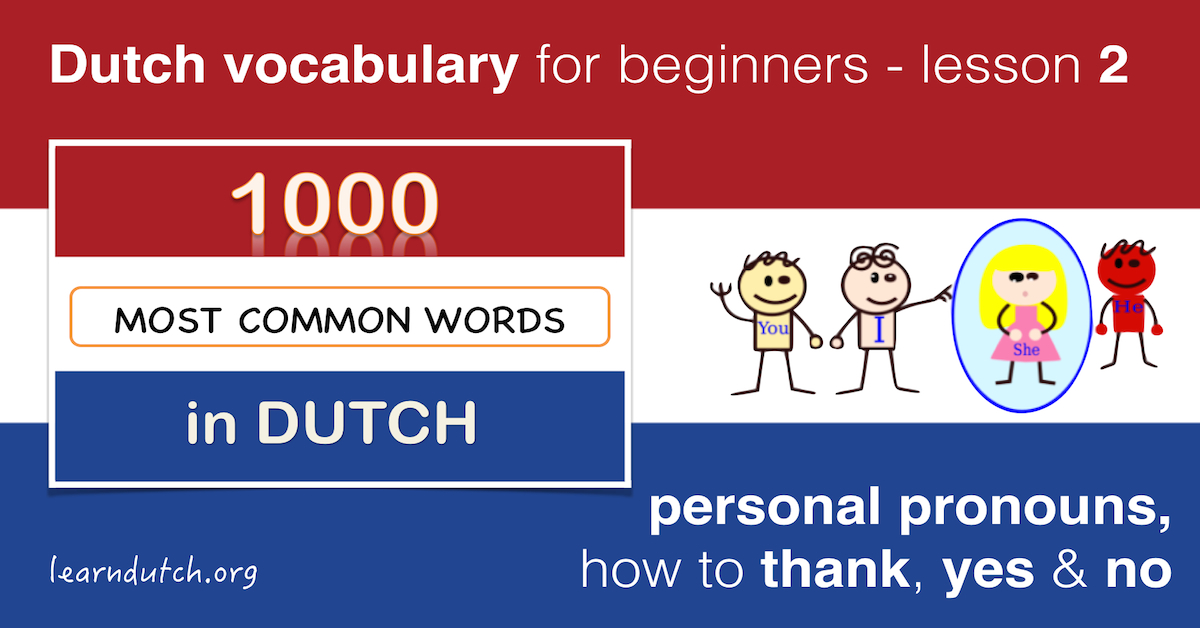
When to use DEZE, DIE, DIT en DAT in Dutch ? Demonstrative pronouns in Dutch explained ! YouTube
All Dutch personal pronouns (in free online video YouTube): I, you, he, she, we, you, they.- With example sentences. With alternative pronunciation: how do y.

A cheat sheet for personal pronouns in Dutch that I quickly threw together. Personal pronouns
to refer to a future event (in combination with an adverb of time) to refer to a hypothetical 'if - then' situation The Dutch word order Those of you who have already struggled with the Dutch word order probably know that the basic order of a Dutch main clause is as follows: subject | finite verb | time | manner | place | other verbs For example:

Dutch grammar applied the personal pronoun as an object (object pronouns in Dutch) YouTube
There are some pronouns that you will be introduced to and start using from your very first Dutch lesson, and when you learn online with Babbel, you'll quickly decipher which are the most essential for use in everyday speech. You'll be introduced to common Dutch personal pronouns such as 'ik' (I), 'we' (we) and 'je' (you), including important.

Dutch Round 1 personal pronouns YouTube
Personal pronouns are words such as I, me, your and it, words which are used to refer to a specific person or actor without having to mention them explicitly. Pronominal forms are a key element of all languages and must be learned early in one's linguistic journey to communicate effectively.

Learn Dutch Grammar _ Possessive Pronouns YouTube
v t e This article outlines the grammar of the Dutch language, which shares strong similarities with German grammar and also, to a lesser degree, with English grammar . Preliminary considerations Vowel length is indicated in Dutch spelling using a combination of double vowels and double consonants.

Dutch for beginners (A1) the personal pronouns YouTube
In Dutch, subject pronouns are used to indicate who or what is performing the action of a sentence. Unlike English, Dutch subject pronouns have different forms depending on whether the noun is singular or plural, and whether it is a masculine, feminine, or neuter noun. Let's take a closer look at the different forms of Dutch subject pronouns:

Dutch Vocabulary Personal Pronouns Learn dutch, Personal pronouns, Dutch language
Learn Dutch online. Lesson 2 - Dutch personal pronouns, how to thank, yes/no.

Dutch vocabulary lesson 2 • Personal pronouns
Dutch for beginners (A1): the personal pronounsLet's learn the personal pronouns in Dutch. We'll review them all and you'll have the opportunity to pronounce.

Possessive Pronouns in the Dutch language YouTube
Compare the English subject pronouns 'I' with the object pronoun 'me', 'he' with 'him', 'they' with 'them', etc. Just like we do for subject pronouns, in Dutch, we make a distinction between marked and unmarked pronouns. We use marked pronouns if we want to stress the pronoun in a sentence. To place emphasis on a word in a sentence, the Dutch.

Basic Dutch Grammar & conversation Learn Pronouns (Voornaamwoord) & Present tense
Possessive names and nouns Colloquial possessives Reflexive pronouns Reflexive pronouns Reciprocal pronouns Reciprocal pronouns Interrogative pronouns Interrogative pronouns Demonstratives Demonstrative pronouns Dependent demonstratives Independent demonstratives Dit is, dit zijn Demonstratives turning into hier/daar Summary Dutch pronouns

Dutch Personal Pronouns Basic Dutch vocabulary Lesson 2, new version! YouTube
The Dutch language has four main pronouns: personal pronouns, possessive pronouns, reflexive pronouns, demonstrative pronouns. These pronouns differ in when they are used, but also have different forms such as stressed and unstressed. When to use which, will be described in detail in the subchapters.

06 To be in Dutch and the pronouns YouTube
Basic personal pronouns in Dutch Jij! (Photo by Dan Burton on Unsplash) Before we get to that difference, let's start with the basics. Ik - I Jij - You Hij/zij/het - He/she/it Wij - We Jullie - You (plural) Zij - They Verbuigen (to conjugate) for these pronouns is pretty easy, too. Let's use the verb fietsen (to bike) as an example: Ik fiets

PPT Dutch Possessive pronomen and direct/indirect object pronomen A1/2 Teaching Resources
Nouns: De kat ("The cat ") Verbs: Wij lopen. ("We walk .") Adjectives (used to describe a noun): De kleine kat ("The little cat") Adverbs (used to describe a verb, an adjective, or another adverb): Ik ga morgen naar school. ("I will go to school tomorrow .") Pronouns (singular or plural):

Dutch PRONOUNS 3 // The 4 functies of JE! shorts YouTube
Ask a question Do you think Dutch pronouns are hard? They can seem a little confusing at first, we'll admit that. You'll have to study them and practice! Luckily we have a nice overview for you and some exercises! Last edit: Tue Oct 17 2023 TDOA Dutch Grammar Pronouns in Dutch: 4 types you need to know Share&Save Hij/Ze/Zij/Het

Dutch personal pronouns that mean YOUR Learn dutch, Personal pronouns, Dutch words
Direct and indirect object pronouns are the same in Dutch, except for "them." Hen is used if it is a direct object, and hun is used if it is an indirect object. Generally, indirect objects are preceded by "to" or "from" in English, and direct objects are not preceded by any prepositions.

Learn Dutch Pronouns 🇳🇱 + free printable Dutch word list pdf 😀 YouTube
By Bieneke Berendsen. A reflexive pronoun is used when the subject and object of a sentence are one and the same, e.g. 'I wash myself". The subject is 'I' and the object 'myself' are the same person. The action that I carry out reflects back on to me, I undergo the washing myself. Hence, the word 'reflexive' pronoun.